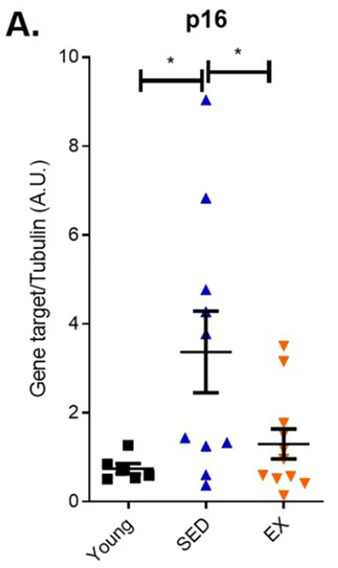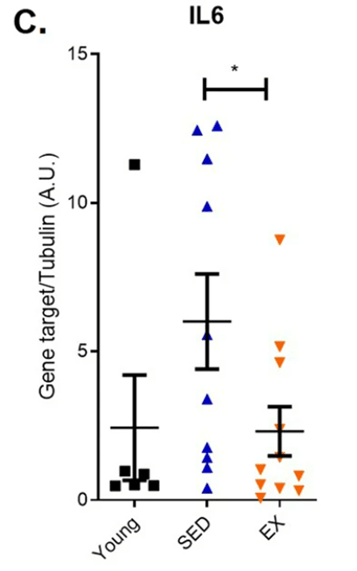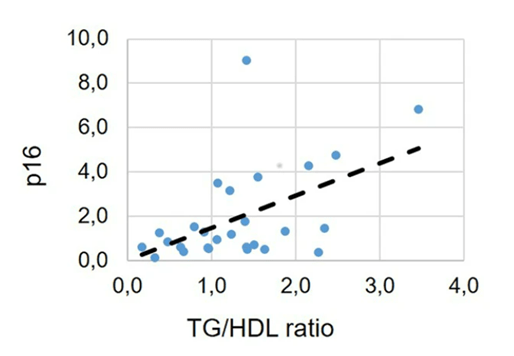Endurance exercise is associated with reduced senescent cells – non-proliferating cells that evade programmed death and emit inflammatory molecules – in the colon of aged runners.
By Brett J. Weiss https://www.nmn.com/news/new-washington-university-study-intensive-endurance-exercise-rids-gut-of-harmful-cells
Highlights
Since ancient times, regularly exercising has been one of the key pillars to maintaining overall good health and aging gracefully. However, to this day, the underlying cellular processes by which exercise confers health benefits remain unclear. Because senescent cell accumulation can contribute to cancer and aging, researchers have turned to a cancer-prone organ – the colon – to help uncover how exercise promotes healthy aging in older adults.
Published in NPJ Aging, Fontana and colleagues from the Washington University School of Medicine show that intensive endurance exercise confers reduced gene activity of the senescent cell protein marker p16 in the guts of aged individuals, indicative of reduced senescent cell numbers. Endurance exercise performed over the course of years alleviated gene activity of a key inflammatory protein – interleukin-6 – associated with senescent cells. Fontana and colleagues went on to show that elevated p16 levels are linked to higher triglyceride to HDL levels – an indicator of increased colon polyp and cardiovascular dysfunction risks. These findings elucidate that intensive endurance exercise likely confers health benefits to the gut by reducing senescent cell abundance in the colon.
Intensive Endurance Exercise Reduces Senescent Cells in Aged Runners’ Colons
Since senescent cells are linked to aging, Fontana and colleagues tested endurance exercise’s effects on senescent cell prevalence in the colon. For this purpose, they took colon biopsies from three groups for comparison: a group of young adults, a group of sedentary older adults, and a group of older adults who regularly practiced endurance running. When they measured gene activity for a protein marker for senescent cells, p16, they found that aged runners and young adults had similar p16 gene activity, but aged, sedentary adults had significantly elevated p16 gene activation. These findings suggest that intensive endurance exercise minimizes the accumulation of senescent cells as marked by gene activity for the protein p16.

(Demaria et al., 2023 | NPJ Aging) Endurance exercise reduces gene activity (mRNA) levels of a senescent cell marker protein, p16, in aged runners. Compared to young adults (Young), sedentary older adults (SED) displayed higher p16 gene activity, yet endurance exercise curtailed this effect in aged runners (EX).
Since senescent cells emit inflammatory proteins, the Washington University-based researchers looked at how endurance running affects gene activity of a key inflammatory protein, interleukin-6. They found that aged runners had significantly less interleukin-6 gene activity levels than aged, sedentary adults. These results add further support that endurance running reduces the abundance of senescent cells in the colon since low-grade inflammation goes along with senescent cell accumulation.

(Demaria et al., 2023 | NPJ Aging) Endurance exercise curtails elevated inflammatory protein interleukin-6 (IL6) in aged runners. Endurance exercise mitigated elevated inflammatory protein interleukin-6 gene activity in aged runners (EX) compared to sedentary older adults (SED).
To find whether senescent cell accumulation plays a role in colon polyp development and potential cardiovascular dysfunction, Fontana and colleagues measured triglyceride to HDL ratios. Researchers have linked elevated triglyceride to high-density lipoprotein ratios to increased risks for colon polyps, metabolic dysfunction, and cardiovascular problems previously. Interestingly, when all of the study participants were pooled, their colon biopsies revealed that elevated p16 protein levels correlate with higher triglyceride to HDL ratios. These findings suggest that elevated p16 levels may induce an increased risk of polyps – 10% of which have the potential to become cancerous – and that endurance running can counter this risk by lowering p16. Moreover, by reducing p16 gene activity, endurance running may also lower the risks for metabolic syndrome and cardiovascular dysfunction.

(Demaria et al., 2023 | NPJ Aging) Higher senescent cell marker protein p16 levels were associated with elevated triglyceride to high-density lipoprotein levels that indicate colon polyp, metabolic dysfunction, and cardiovascular problem risks. In pooled aged study participants, elevated p16 senescent cell protein marker levels correlated with higher triglyceride to high-density lipoprotein levels, indicative of higher risks for colon polyp risk – 10% of which have the potential to turn to cancer.
Finding What Exercise Regimens Reduce Senescent Cells and In What Organs
The study has a number of limitations. For example, Fontana and colleagues only examined endurance exercise’s effects on the colon of aged runners. Future studies should examine whether intensive endurance exercise reduces senescent cell buildup in other tissues, such as the liver or kidneys. Another limitation to the study was that high-intensity running regimens of 40+ miles run per week were examined. Not many adults have the time or physical capacity to run this amount during a week. As such, figuring what exercise regimens are most conducive to exercise’s senolytic effects should be explored. Along those lines, a recent study showed that high intensity training lowers p16 gene activity, yet moderate exercise doesn’t. Another study showed that resistance training on a weight machine lowered p16 levels in aged, overweight women.
As future research unfolds, we can expect to learn more and more about how exercise benefits us physically and leads to healthier aging. As such, it would be interesting to find how different exercise regimens compare to senolytic agents regarding their capabilities to eliminate senescent cells.
Model and Dosage
Model: Aged humans (average age of 57 years)
Dosage: Running an average of 48 miles per week
TAGS
Colon, Endurance Exercise, Inflammation, Running, SASP, Senescent Cells
Story Source
Demaria M, Bertozzi B, Veronese N, Spelta F, Cava E, Tosti V, Piccio L, Early DS, Fontana L. Long-term intensive endurance exercise training is associated to reduced markers of cellular senescence in the colon mucosa of older adults. NPJ Aging. 2023 Feb 27;9(1):3. doi: 10.1038/s41514-023-00100-w. PMID: 36849522; PMCID: PMC9971019.